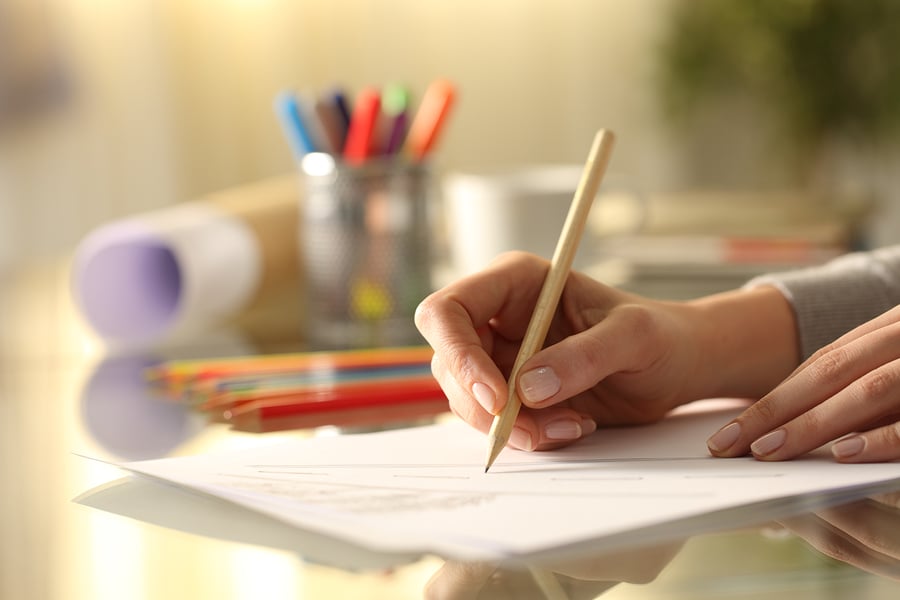Can creating art help your mental health?
Whether it’s doing a virtual class or doodling at home, art can be a great form of mindfulness
After a year of various stay-at-home orders, many of us have picked up new hobbies to help pass the time – such as painting, sketching or sewing.
Creating art isn’t just a way of filling up your weekends – it could also have a positive impact on your mental wellbeing. A new report from the Royal College of Psychiatrists and the Royal College of Occupational Therapists says ‘social prescribing’ – where health professionals refer patients to non-clinical services, such as art classes, group gardening projects or playing football in a local team – could help combat the mental health fallout from the pandemic.
Social prescribing should be done to complement existing treatments, rather than replace them, but it could help decrease loneliness and improve mental and physical health.
🎨Time to get creative as #GraysonsArtClub is back with @Alan_Measles and @Philippa_Perry. Tonight @BoyGeorge, @AnnekaRice, @HarryHill and viewers at home have all produced works of art inspired by the theme FAMILY. 8pm on @Channel4 pic.twitter.com/De5bk2RHsx
— Channel 4 Press (@C4Press) February 26, 2021
Whether it’s getting into the trend for paint by numbers or avidly following Grayson’s Art Club on TV, there’s a reason so many of us have fallen back in love with art recently.
Speak to your GP if you have any questions about social prescribing or your mental health, but if you’re keen for more moments of mindfulness in your day, art might be the way forward…
It can calm the mind
Art is “a mindful pursuit”, explains psychologist Audrey Tang, author of The Leader’s Guide to Resilience. “It can calm our mind and give us a bit of headspace.”
With more of us working from home, it can feel increasingly difficult to take a step back from the combined stresses of work and home life – but art could help.
Tang says: “Just take mindless doodling. Even if you’re not an artist, you can do something known as a Zentangle – simply drawing a rectangle, and then drawing shapes within it – any shapes, anything you like. If you focus on that, particularly if you’re not the type of person who can sit and breathe and meditate, you will actually find it still has the effect of slowing our mind down. It’s about taking that moment to ourselves, giving ourselves what I like to call a mental palate cleanse.”
The psychologist suggests taking time out of your day to doodle can help you go back to whatever you were doing “with a slightly clearer approach”. When doing art “we’re concentrating on something other than our worries without even realising it”, she explains – something we all need every now and again.
You can take ownership of something
Art “is for you, and that’s probably the most important thing”, says Tang. “When it comes to self-expression, the key is the self – it’s for us to get those feelings out, it’s for us to learn a little bit more about ourselves, and no one else needs to be part of that journey.”
No matter how skilled an artist you are, ultimately “you’ve created something that’s yours, you’ve got ownership of it – it’s something that belongs to you and you’ve got that sense of pride”, the psychologist explains.
Group classes can boost your wellbeing
Social prescribing recommends group activities like art classes, and Tang says: “If we meet like-minded people, we get to chat, we expand on our social circle, we build on our skills – those are really positive elements for our wellbeing in general.”
Particularly as loneliness is on the rise – according to the Office for National Statistics, 86% of women and 74% of men reported feeling lonely at the end of January – meeting new people could help combat this.
As many of us are still in lockdown, in-person art classes aren’t possible – but there are still plenty of options for online and Zoom sessions, which Tang advocates, as “you’re still interacting”.
How to get started
You don’t need expensive oil paints to create art, says Tang: “If you’ve got a pencil and a piece of paper, you can still draw.”
She recommends watching free video tutorials on YouTube: “That way, you can try different techniques and different types of teachers, so before you even pay money for a class, you’ve at least got an idea of the style of teaching you like, or the style of art you want to explore.”
If you’re looking for something with a bit less structure, Tang recommends you “just give it a go – take a pencil and paper and go out and see what happens when you draw”.
You don’t have to be a professional artist to reap the mental benefits, notes Tang. “No one needs to see it, no one needs to mark you on it – it’s not school – so just go for it.”
Visit our Silversurfers Craft section for more creative ideas.
The Press Association
Latest posts by The Press Association (see all)
- Special stamps to mark 80th anniversary of VE Day - April 24, 2025
- Test your knowledge with our penguin-themed quiz - April 24, 2025
- Prince Louis shows off missing front teeth in new photo to mark seventh birthday - April 23, 2025
- Why does hearing get worse as we get older? - April 23, 2025
- Top scented plants for your garden, from a Kew expert - April 22, 2025



















